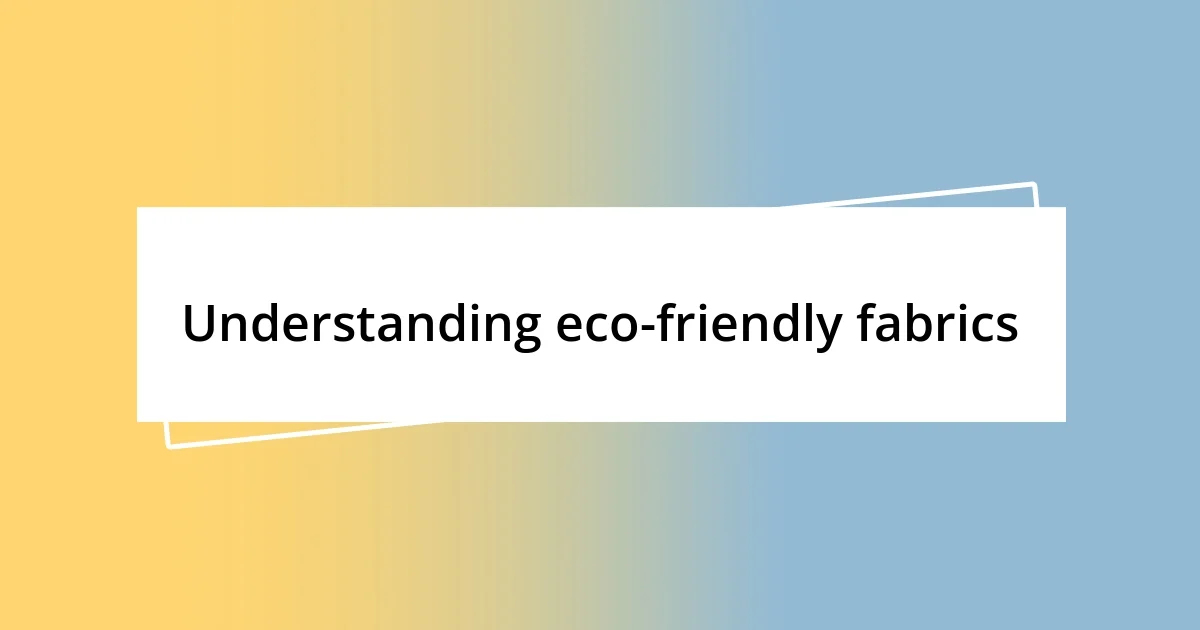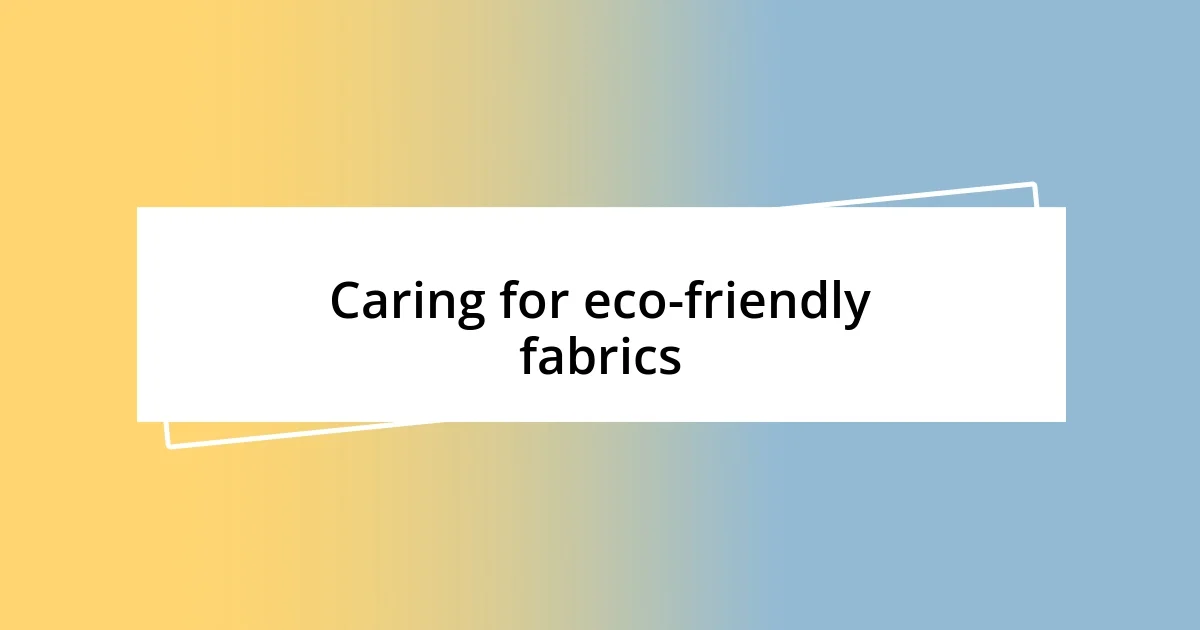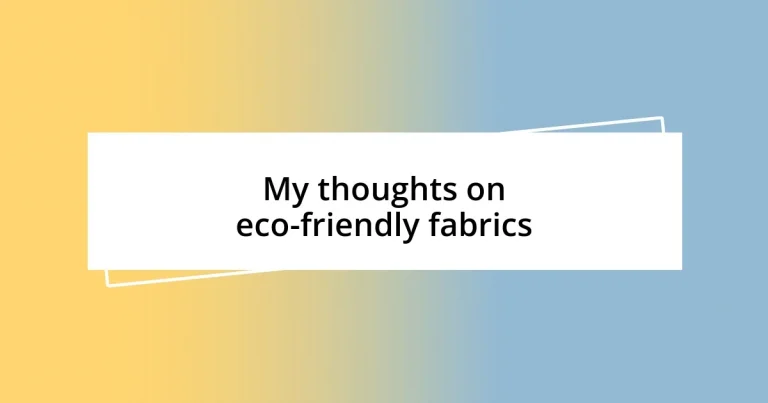Key takeaways:
- Eco-friendly fabrics, such as organic cotton and bamboo, offer low environmental impact, comfort, and unique textures, enhancing sustainable fashion choices.
- Key benefits include sustainability, reduced toxicity, durability, biodegradability, and improved personal well-being through mindful fabric selection.
- Future trends in eco-friendly fabrics involve innovations like bio-fabrication, closed-loop production, and support for ethical brands, promoting a movement toward responsible consumerism.

Understanding eco-friendly fabrics
Eco-friendly fabrics are made from materials that have a low environmental impact, and understanding their significance is essential for those of us looking to make sustainable choices. I remember the moment I first encountered organic cotton—it felt like a revelation. The soft texture and the knowledge that it’s grown without harmful pesticides made me appreciate not just the fabric but the entire process behind it.
Have you ever thought about how the fashion industry contributes to pollution? Much of it stems from conventional fabrics, which often involve toxic chemicals and wasteful practices. When I discovered fabrics made from recycled materials, it opened my eyes to the possibility of repurposing waste into something functional and beautiful. It’s incredibly rewarding to wear something with a story and a positive impact on the planet.
Exploring the world of eco-friendly fabrics can feel overwhelming at first, but I encourage you to take it step by step. From bamboo to hemp, each material has unique benefits that resonate with different lifestyles and values. When I started incorporating these fabrics into my wardrobe, I felt a sense of empowerment—knowing that my choices could support a healthier planet. How about you? What steps are you taking towards a more sustainable wardrobe?

Benefits of eco-friendly fabrics
The benefits of eco-friendly fabrics extend far beyond their environmental impact; they also enhance our personal well-being. I still vividly recall the first time I wore a shirt made from Tencel, derived from eucalyptus trees. The fabric felt like a gentle embrace, breathability included, which not only kept me comfortable but also made me feel good about my decision to choose sustainability. This is the kind of fabric that doesn’t just treat my skin kindly; it also minimizes water usage in production, reflecting a mindful approach to resources.
Here’s a quick breakdown of some key benefits of eco-friendly fabrics:
- Sustainable Materials: Often sourced from renewable resources, reducing depletion of natural resources.
- Less Toxicity: Lower chemical use in the growing and manufacturing process means healthier living environments.
- Durability: Many eco-friendly fabrics are designed to withstand wear, promoting longevity over fast fashion.
- Biodegradability: Natural fibers often break down more easily in the environment, reducing landfill waste.
- Unique Textures: Fabrics like organic cotton or bamboo not only feel great but often have distinct aesthetics that set them apart from conventional materials.
Each time I choose to wear an eco-friendly fabric, I’m reminded of the beautiful intersection between comfort and conscience. It feels liberating to wear something that aligns with my values while also being stylish.

Types of eco-friendly fabrics
When exploring types of eco-friendly fabrics, I find myself drawn to natural fibers like organic cotton, linen, and hemp. I remember switching to linen for my summer wardrobe. It was an experience—this fabric is so breathable that it felt like I was wearing nothing at all! Not to mention, it’s made from flax plants, which require minimal water and pesticides. That’s a win-win for both comfort and the environment.
Then there’s bamboo, which I’ve personally come to love. Beyond its sustainability aspect, the texture is incredibly soft and luxurious. Plus, it grows rapidly without harmful chemicals. I can’t help but think about how it’s almost like wearing a cloud. This versatility in eco-friendly fabrics allows us to embrace comfort while being conscientious. Have you ever tried wearing a bamboo product? You might be surprised at how delightful it feels against your skin.
Lastly, fabrics like Tencel and recycled polyester have caught my attention, too. Tencel, derived from sustainably sourced wood, has an elegant drape and is perfect for a range of garments. When I picked up a Tencel dress, I couldn’t believe how beautifully it flowed with every movement. On the other hand, recycled polyester, made from plastic bottles, is a brilliant way to tackle waste. I often wonder—what do you think the fashion landscape would look like if more brands embraced these innovative materials?
| Fabric Type | Characteristics |
|---|---|
| Organic Cotton | Soft, breathable, grown without pesticides |
| Linen | Lightweight, highly breathable, minimal water usage |
| Bamboo | Soft, luxurious feel, grows rapidly without chemicals |
| Tencel | Sustainable wood source, elegant drape, moisture-wicking |
| Recycled Polyester | Made from plastic bottles, promotes recycling, durable |

How to choose eco-friendly fabrics
When selecting eco-friendly fabrics, it’s crucial to consider their source. I remember a time when I bought a sweater labeled “organic wool”; I didn’t realize it came from a farm that prioritized animal welfare. Knowing the story behind the fabric was almost as comforting as wearing it on chilly days. It made me question: How much do we really know about our clothing’s origins? Understanding the supply chain not only enriches our experience but also reinforces our commitment to sustainable choices.
Another aspect to reflect on is the fabric’s production process. I once attended a local workshop where artisans demonstrated how they dyed cotton using natural plant-based ingredients. It opened my eyes to how much care goes into creating a fabric that is not just eco-friendly but also aesthetically pleasing. I’ve learned that by opting for products with lower chemical use, I’m contributing to healthier ecosystems. It’s a small change, yet it feels empowering.
Lastly, durability should be top of mind. I distinctly recall the first time I wore a pair of eco-friendly denim jeans—crafted with organic cotton and dyed using less water. Even after numerous washes, they held their shape beautifully. This experience made me ponder: Isn’t investing in quality over quantity a form of self-care? Choosing durable fabrics not only means less waste but also more value in the long run.

Caring for eco-friendly fabrics
Caring for eco-friendly fabrics doesn’t have to be complicated; in fact, it can be quite enjoyable! I remember the first time I hand washed a delicate hemp shirt. The process felt like a little ritual, where I took my time, gently soaking it in cold water with a mild soap. The fabric seemed to appreciate the care, retaining its softness and earthy texture. It’s a gentle reminder that by nurturing our garments, we contribute to their longevity and, in turn, the planet.
When it comes to drying these eco-friendly treasures, I’ve found air drying to be the best method. One sunny afternoon, I hung my organic cotton dresses outside, letting the breeze fluff them up naturally. The result? A fresh scent that no dryer could replicate! Plus, this simple step reduces energy consumption, reinforcing my commitment to sustainability. Ever tried it? I highly recommend giving it a go—it adds a little more life to your clothing.
It’s essential to be mindful of the detergents we use as well. I once switched to a plant-based laundry soap after learning about the harsh chemicals in traditional options. The difference was astounding! Not only did my clothes feel softer, but I felt equally good knowing I was being kinder to the environment. Have you considered what your laundry routine could contribute to your eco-friendly lifestyle? It’s the small changes that often create the most significant impact.

Comparing eco-friendly fabrics
When comparing eco-friendly fabrics, one of the first distinctions I find important is between natural and synthetic options. For instance, I had a fascinating experience trying out Tencel, a fabric made from wood pulp. I remember marveling at its silky smoothness and breathability, making me rethink my previous perceptions of sustainable fabrics. It’s a gentle nudge to consider: can sustainable also mean luxurious?
Another thing I’ve noticed is the varied impact of organic vs. conventional materials. A few months back, I purchased organic cotton sheets that felt so much softer than my previous ones, which were mass-produced. That difference in comfort reminded me just how beneficial organic farming can be—not just for my sleep but for the farmers and land too. Isn’t it remarkable how something as simple as choosing organic can ripple through an entire ecosystem?
Finally, the environmental footprints of these materials can be eye-opening. I remember digging into the water usage of different fabric types and was surprised to learn that conventional cotton consumes staggering amounts of water. In contrast, some alternatives, like hemp, require significantly less. This discovery made me question my fabric choices: how could I align my wardrobe more closely with my eco-friendly values? By making slight tweaks, I feel I can truly contribute to a more sustainable future.

Future trends in eco-friendly fabrics
I see exciting potential in the future of eco-friendly fabrics. Recently, I came across innovations like bio-fabricated materials, which are grown in labs rather than from traditional agriculture. Can you imagine wearing clothing made from mycelium, the root system of mushrooms? The texture blew me away—it was soft yet sustainable, bridging the gap between nature and technology.
Moreover, I’m thrilled to see the rise of closed-loop production methods. Just the other day, I learned about a brand that takes back old garments to recycle their fibers, turning waste into new fabric. This circular approach to fashion not only reduces landfill waste but also aligns perfectly with my desire to make mindful choices. Have you ever thought about what happens to your clothes at the end of their life cycle? It’s empowering to know our choices can contribute to a healthier planet.
There’s also a growing community focused on supporting ethical brands and local production. I remember chatting with a small business owner who passionately shared her journey of sourcing organic fibers from local farmers. The connection was so palpable—I could feel the love for the craft and the environment. It made me realize that choosing eco-friendly fabrics is more than just a trend; it’s a movement towards responsible consumerism and supporting the artisans who care about our planet. Wouldn’t it be wonderful if more of us took that path?














